Milliradian
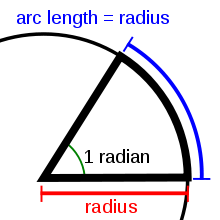
A milliradian, simply called a mil or mrad (often capitalized MRAD), is an angular measurement which is defined as a thousandth of the radian ( = 0.001 radian), meaning that a full circle of 360° (degrees) corresponds to 2000π or approximately 6283 milliradians.
One milliradian equals approximately 0.057296 degrees or 3.4377 minutes of arc (MOA). The unit and some variants are often used to facilitate accurate aiming of guns, ranging from rifles to heavy artillery.
Uses
The exact definition of a mil (circle/6283.185…) is used in optical reticles and on scope adjustment knobs ("turrets").
There are also derived (approximated) definitions used for land mapping and artillery, where for instance a compass with 6400 NATO mils is used instead of a 360° compass, achieving higher precision. The term angular mil is used in artillery. Other derived definitions of 6000 or 6300 mils per circle also exist depending on country, see below.
Mil adjustment is commonly used in the mechanic adjustment of iron and scope sights in shooting sports, where sight adjustment using mils is particularly useful together with metric units when shooting at regular distances such as 100 m or 300 m, because for instance one click of a sight adjustment of 0.1 MRAD will move the point of impact exactly 1 cm at 100 m and 3 cm at 300 m respectively. This is not the case when using MOA with imperial units, where one often simplifies 1 MOA being equal to 1 inch at 100 yards while in reality 1 MOA at that distance equals 1.047 inches, producing a small error that will increase the more the sight is adjusted or the longer the shooting distance. Therefore in particular a spotter in long range shooting (i.e 1000 m and above) theoretically can provide more precise shot corrections using a mil reticle.
Mil reticles can easily be used in optics for range estimation because of the precise mathematical simplification that can be made with such small angular measurements, exploiting the attribute of radians that a small angle is a good approximation to its sine. For range estimation, using metric units will again be particularly useful because it requires less mental calculation in the field. Using the range estimation formula with the units meters for range and millimeters for target size it is just a matter of moving decimals and do the division, without the need of multiplication with additional constants, thus producing fewer rounding errors.
History
The milliradian (circle/6283.185…) was first used in the mid nineteenth Century by Charles-Marc Dapples (1837–1920), an engineer and professor at the University of Lausanne.[1] Degrees and minutes were the usual units of angular measurement but others were being proposed, with “grads” (circle/400) under various names having considerable popularity in much of northern Europe. However, Imperial Russia used a different approach, dividing a circle into equilateral triangles (60°, circle/6) and hence 600 units to a circle.
Around the time of the start of World War I, France was experimenting with the use of milliemes (circle/6400) for use with artillery sights instead of decigrades (circle/4000). The United Kingdom was also trialing them to replace degrees and minutes. They were adopted by France although decigrades also remained in use throughout World War I. Other nations also used decigrades. The United States, which copied many French artillery practices, adopted mils (circle/6400). Before 2007 the Swedish defence forces used "streck" (circle/6300, streck meaning lines or marks) (together with degrees for some navigation) which is closer to the milliradian but then changed to NATO mils. After the Bolshevik Revolution and the adoption of the metric system of measurement (e.g. artillery replaced “units of base” with meters) the Red Army expanded the 600 unit circle into a 6000 mil one. Hence the Russian mil has nothing to do with milliradians as its origin.
In the 1950s, NATO adopted metric units of measurement for land and general use. Mils, meters, and kilograms became standard, although degrees remained in use for naval and air purposes, reflecting civil practices.
Mathematical principle
Use of the Mil-dot system is possible because it is concerned with small angles, and at small angles:
This allows a user to dispense with trigonometry and use simple ratios to determine size and distance with high accuracy for rifle and short distance artillery calculations.
Since a radian is mathematically defined as the angle formed when the length of a circular arc equals the radius of the circle, a trigonometric milliradian (mrad), is the angle formed when the length of a circular arc equals 1/1000 of the radius of the circle. Since the radian expresses a ratio, it is independent of the units of length used.
Firearm sights
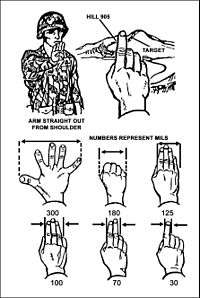
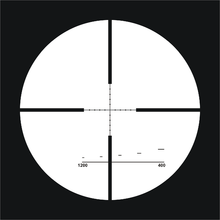
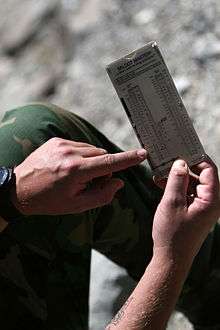
The angular mil is commonly used both in the military and civilian shooting sports as a unit for clicks on scope adjustments knobs (turrets), and in optical reticles allowing rough range estimation and precise shot correction. The mils relationship to the trigonometric radian gives rise to the handy property of subtension: One mil approximately subtends one metre at a distance of one thousand metres. More formally the small angle approximation for skinny triangles shows that the angle in radians approximates to the sine of the angle.
Mil adjustment
Adjustments of 0.1 and 0.2 MRAD are common on fiream sights, which makes one click of adjustment correspond to exactly 1 cm and 2 cm at 100 m respectively.
Mil reticles
Many telescopic sights used on rifles have reticles that are marked in angular mils. This can either be accomplished with lines or dots, and the latter is generally called mil-dots. The mil reticle serves two purposes, range estimation and trajectory correction.
With a mil reticle-equipped scope the distance to an object can be estimated with a fair degree of accuracy by a trained user by determining how many angular mils an object of known size subtends. Once the distance is known, the drop of the bullet at that range (see external ballistics), converted back into angular mils, can be used to adjust the aiming point. Generally mil-reticle scopes have both horizontal and vertical crosshairs marked; the horizontal and vertical marks are used for range estimation and the vertical marks for bullet drop compensation. Trained users, however, can also use the horizontal dots to compensate for bullet drift due to wind. Mil-reticle-equipped scopes are well suited for long shots under uncertain conditions, such as those encountered by military and law enforcement snipers, varmint hunters and other field shooters. These riflemen must be able to aim at varying targets at unknown (sometimes long) distances, so accurate compensation for bullet drop is required.
Mixing MIL and MOA
It is possible to purchase rifle scopes with a mix of for instance a MIL reticle and MOA turrets (or vice versa), but it is general consensus that such mixing should be avoided. It is preferred to either have both a MIL rerticle and MIL adjustment (MIL/MIL), or a MOA reticle and MOA adjusment (MOA/MOA) to utilize the strength of each system. Then the shooter can know exactly how many clicks to correct based on what he sees in the reticle.
Range estimation
Angle can be used for either calculating size or range. Where the range is known the angle will give the size, where the size is known then the range is given. When out in the field angle can be measured approximately by using calibrated optics or roughly using one's fingers and hands. With an outstretched arm one finger is approximately 30 mils wide, a fist 150 mils and a spread hand 300 mils.
Angle can be used for calculating range. For objects of known size the range is the size divided by the angle. Land Rovers are about 3 to 4 m long, "smaller tank" or APC/MICV at ~6 m (e.g. T-34 or BMP) and ~10 m for a "big tank." From the front a Land Rover is about 1.5 m, most tanks around 3 - 3.5 m. So a SWB Land Rover from the side are one finger wide at ~100 m. A modern tank would have to be at a bit over 300 m.
Formula
Users of the metric system (which includes most of the world's military forces by whom this system was developed), can much more easily use a mil reticle since the mental arithmetic is much simpler with decimal units.
To determine the distance or range to a target of known size at an observed angle of view this formula can be applied:
where:
- D = Distance to the target
- S = Size of the target
- M = Measurement in mils
Here D and S can be given in any two units of length with a ratio of 1000:1, so instead of meters and millimeters it can be for example kilometers and meters, respectively.
If for instance a target known to be 1.5 m wide (1500 mm) is measured to 2.8 mils in the reticle, the range can be estimated to:
So if the above-mentioned 6 m long BMP (6000 mm) is viewed at 6 mils its distance is 1000 m, and if the angle of view is twice as large (12 mils) the distance is half as much, 500 m.
When used with some riflescopes of variable objective magnification and fixed reticle magnification (where the reticle is in the second focal plane), this can be modified to:
where:
- D = distance to target in meters
- S = actual size of target in millimeters
- M = the observed angle of view of target measured in mils
- mag = scope magnification
(However, a user should verify this with their individual scope since some are not calibrated at 10x.)
As above, D and S can be given in any two units of length with a ratio of 1000:1.
Metric conversion
Mils are easy to use with metric units.
| Angle | @ 100 m | @ 200 m | @ 300 m | @ 400 m | @ 500 m | @ 600 m | @ 700 m | @ 800 m | @ 900 m | @ 1000 m |
|---|---|---|---|---|---|---|---|---|---|---|
| 0.1 mil | 1 cm | 2 cm | 3 cm | 4 cm | 5 cm | 6 cm | 7 cm | 8 cm | 9 cm | 10 cm |
| 0.2 mil | 2 cm | 4 cm | 6 cm | 8 cm | 10 cm | 12 cm | 14 cm | 16 cm | 18 cm | 20 cm |
| 1 mil | 10 cm | 20 cm | 30 cm | 40 cm | 50 cm | 60 cm | 70 cm | 80 cm | 90 cm | 100 cm |
| 5 mil | 50 cm | 100 cm | 150 cm | 200 cm | 250 cm | 300 cm | 350 cm | 400 cm | 450 cm | 500 cm |
- 1 mil = 3.438 moa
- 1 moa = 0.291 mil
- 0.1 mil equals 1 cm at 100 m
- 1 moa equals 0.291 mil (or 2.91 cm ≈ 3 cm at 100 m)
Formula for Imperial units
To determine the distance to a target of known size: (Distance in yards) = 1000 / 36 x (Object size in inches) / Mils
To determine the size of a target at a known distance: (Object size in inches) = 36 / 1000 x (Distance in yards) x Mils
Knowing these relationships, you can set up a target range by drawing a vertical or horizontal line onto our target that is 3.6 inches long then backing up until the line is exactly one mil long in your scope for a 100-yard range, 7.2 inches for 200 yards, 10.8 inches for 300 yards, etc.
Known Target Size (8 inch) Ranging:
| Target, inches | Mils | Distance, yards |
|---|---|---|
| 8 | 0.1 | 2222 |
| 8 | 0.2 | 1111 |
| 8 | 0.3 | 741 |
| 8 | 0.4 | 556 |
| 8 | 0.5 | 444 |
| 8 | 0.6 | 370 |
| 8 | 0.7 | 317 |
| 8 | 0.8 | 278 |
| 8 | 0.9 | 247 |
| 8 | 1.0 | 222 |
| 8 | 1.1 | 202 |
| 8 | 1.2 | 185 |
| 8 | 1.3 | 171 |
| 8 | 1.4 | 159 |
| 8 | 1.5 | 148 |
| 8 | 2.0 | 111 |
| 8 | 2.2 | 101 |
| 8 | 3.0 | 74 |
| 8 | 4.0 | 56 |
| 8 | 5.0 | 44 |
| 8 | 6.0 | 37 |
| 8 | 7.0 | 32 |
| 8 | 8.0 | 28 |
| 8 | 9.0 | 25 |
| 8 | 10.0 | 22 |
Definitions for maps and artillery
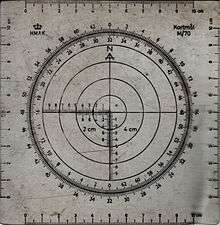
There are 2000π milliradians (≈ 6283.185 mrad) in a circle; thus a milliradian is just under 1⁄6283 of a circle, or ≈ 3.438 minutes of arc. Each of the definitions of the angular mil are similar to that value but are easier to divide into many parts.
- 1⁄6283 The “real” trigonometric unit of angular measurement of a circle in use by telescopic sight manufacturers using (stadiametric) rangefinding in reticles.
- 1⁄6400 of a circle in NATO countries.
- 1⁄6000 of a circle in the former Soviet Union and Finland (Finland phasing out the standard in favour of the NATO standard).
- 1⁄6300 of a circle in Sweden. The Swedish term for this is streck, literally "line". Sweden (and Finland) have not been part of NATO nor the Warsaw Pact. Note however that Sweden has changed its map grid systems and angular measurement to those used by NATO, so the "streck" measurement is obsolete.
Use in artillery sights
Artillery uses angular measurement in gun laying, the azimuth between the gun and its target many kilometres away and the elevation angle of the barrel. This means that artillery uses mils to graduate indirect fire azimuth sights (called dial sights or panoramic telescopes), their associated instruments (directors or aiming circles), their elevation sights (clinometers or quadrants), together with their manual plotting devices, firing tables and fire control computers.
Artillery spotters typically use their calibrated binoculars to walk fire onto a target. Here they know the approximate range to the target and so can read off the angle (+ quick calculation) to give the left/right corrections in metres.
1 trigonometric milliradian (mrad) ≈ 3.43774677078493 MOA
1 NATO mil = 3.375 MOA (exactly)
See also
References
- ↑ Renaud, Hugues (2002-05-31). Dictionnaire historique de la Suisse. Fonds, AV Laussane.
Dapples: ... Charles-Marc (1837-1920), ingénieur, professeur à l'université de Lausanne, municipal à Lausanne, est l'inventeur de l'unité appelée "millième" pour mesurer les angles dans le tir d'artillerie. Une branche de la famille s'est fixée à Gênes à la fin du XVIIIe s.